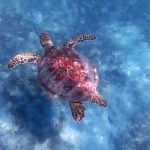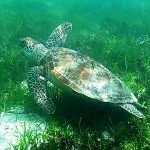GREEN SEA TURTLE
Sharon: A large Green Sea Turtle surfaced close to me while i was sitting on a jetty, just gazing out at the ocean that surrounds our island continent.
Ocean Voyager and Ecosystem Guardian
Drifting gracefully through the sun-dappled waters, the Green sea turtle is a living emblem of the ocean’s gentle power. Its heart-shaped carapace, reaching up to 1.5 metres, shines with a mosaic of olive and brown, echoing the shifting hues of seagrass under shifting light. As you draw nearer, you notice the turtle’s limb-like flippers, sculpted for seamless movement, and its modestly sized head with a beak-like mouth designed for grazing underwater meadows.
While it is named for the subtle green tint of its inner fat—coloured by its vegetation-based diet—its shell rarely carries this hue. Instead, you’ll see swirling patterns, reminiscent of underwater currents, lending each turtle a unique identity woven by nature’s hand.
Life on the Ocean’s Highways
Green sea turtles are true voyagers. Their range spans tropical and subtropical seas across the globe. Australian waters are particularly blessed with these ancient mariners, especially along the intricate ribbons of the Great Barrier Reef and the expansive shores of Western Australia. Turtles favour shallow coastal habitats—aquatic pastures of seagrass and coral sanctuaries that offer both sustenance and shelter.
| Region | Key Habitats |
|---|---|
| Great Barrier Reef | Seagrass beds, coral lagoons |
| Western Australia | Coastal bays, fringing reefs |
The Epic Life Cycle
One of the most astonishing aspects of the green sea turtle’s life is its reproductive journey. After years adrift, females return to the very sands of their birth—undertaking migratory feats guided by the Earth’s magnetic fields. Nesting takes place every 2–5 years:
- Night Arrival: Under the cover of darkness, the female hauls herself ashore.
- Egg Laying: She digs a nest and deposits up to 200 eggs.
- Incubation: Sand temperature determines the hatchlings’ sex. Warmer sand often produces more females.
- Hatchling Dash: After two months, the eggs hatch, and a flurry of tiny turtles races towards the silvery glow of the moonlit sea—a perilous journey fraught with danger, where only a few will survive.
The crunch of sand beneath their tiny flippers, the salty breeze, and the shimmering reflection of moonlight on water make this event one of nature’s timeless dramas.
Eating for the Ecosystem
In their youth, green sea turtles may sample a varied diet, but as adults, they become predominantly herbivorous, grazing in vast underwater meadows:
- Diet: Seagrass, algae, occasionally small invertebrates as juveniles.
- Ecological Role: Their grazing maintains the strength and diversity of seagrass beds—vital habitats that support countless marine creatures and help counteract coastal erosion.
Communication and Longevity
Green sea turtles may seem silent, yet research reveals they produce low-frequency sounds, especially during interactions or when stressed, creating a subtle symphony incomprehensible to human ears but essential for turtle-to-turtle communication. With lifespans often spanning 60–80 years—and sometimes longer—these turtles embody resilience, surviving decades of oceanic change.
Facing Peril and Inspiring Hope
Despite their strength and adaptability, green sea turtles are listed as endangered. They confront:
- Habitat loss from coastal development
- Pollution, including plastic waste and oil spills
- Bycatch in fishing operations
- Poaching for eggs, meat, and shells
Conservation: A Shared Responsibility
Efforts to protect green sea turtles focus on:
- Safeguarding nesting beaches
- Regulating fisheries to prevent accidental capture
- Reducing marine pollution
- Raising public awareness
A Call to Protect
The green sea turtle is more than a creature of beauty; it is an architect of the seafloor and a sentinel for healthy ecosystems. Each story of a hatchling reaching the sea, or of an adult gliding through coral gardens, reminds us of our connection to the wider tapestry of life. By choosing to protect these marine wonders, we safeguard not just a species, but the intricate health of our oceans—for today, and for generations yet to come.
When next you walk along an Australian beach or peer into coastal waters, imagine the silent journeys of these ancient navigators—and consider what part you might play in ensuring their story continues.
















